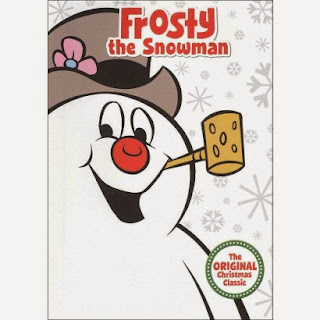Rotten Tomatoes score: 60%
How strange that Rotten Tomatoes has critics' reviews for this thing. Previous "TV specials" on my list have always had to do without official scores, but this phoned-in 30-minute cartoon gets the full treatment.
Well, maybe "full treatment" is an overstatement—there are a total of five reviews, and only two are from sources I've heard of. Anyway, it's a number, so I'll just go with it.
The song "Frosty the Snow Man" was written for and recorded by Gene Autry in 1950, in a conscious attempt to follow up on Autry's previous hit "Rudolph the Red-Nosed Reindeer." Many years later, after Rankin/Bass had struck gold with their Rudolph movie, they decided to give Frosty a try too.
It seems that their goal with Frosty the Snowman was to recapture the spirit of Rudolph, but to put absolutely no thought, effort, or money into it whatsoever. Rudolph's stop-motion animation looks charmingly old-fashioned; Frosty looks a notch or two above Clutch Cargo. Rather than stop-motion, they went in for traditional hand-drawn animation, but it's the corner-cutting, Xerox-heavy animation style that was all the rage in cheaply-produced Hanna-Barbera cartoons.
(Have you ever wondered why Fred Flintstone and George Jetson have five o'clock shadows all the time, or why Yogi Bear wears a tie? It's because the animators needed clear boundary lines between their body parts, so that they would only have to animate the bare minimum, then paste it into a still image of the rest of the body. Try talking without moving any part of your face except your mouth; it's not as easy as Fred makes it look.)
As with all Rankin/Bass movies, this one is hosted by a celebrity narrator, depicted on-screen as an animated representation of himself. Frosty has Jimmy "Schnozzola" Durante, who also sings the title song. (Isn't it weird when you hear some actor sing for the first time, and you think, "Wow, I never knew he had such a good voice"? This is not one of those times.) The rest of the cast consists of a lot of famous people I'm not familiar with.
As you would expect, the movie starts with the premise of the song: A bunch of kids build a snowman out of "Christmas snow," and when they place an old silk hat on his head, he comes to life. But did you ever wonder where the "old silk hat" came from? Well hold onto your seats—it came from a self-described "evil magician" named Professor Hinkle, who threw the hat away after a failed performance in the children's elementary school classroom. I bet you didn't expect that. Now, once Hinkle discovers that his hat is really magic, he decides to steal it back, even though he knows this will snuff out the life of an animate being.
Meanwhile, Frosty and the kids have another situation on their hands. The temperature is starting to rise, and Frosty is afraid he will melt unless he takes a train to the North Pole immediately. (Frosty doesn't know how to count to ten or what a traffic light is, but he has an instinctive understanding of thermometers and the location of the North Pole.) He decides to stow away on a refrigerated boxcar, and he invites one of the human children to come along for the ride. Karen is apparently the stupidest 10-year-old alive, as she believes she can make it to the North Pole and back before bedtime. What's more, Professor Hinkle is also aboard, scheming to take back his hat at the first opportunity.
As the freezer car rambles on northward, the inherent tragedy of his life dawns on Frosty. He realizes that the cold that sustains his life is slowly inflicting hypothermia on Karen, so he takes her out of the freezing boxcar and into the freezing wilderness. Frosty's rabbit pal Hocus Pocus hops off to fetch Santa Claus for help, while Frosty carries Karen to a conveniently-located heated greenhouse. But wouldn't you know it, Professor Hinkle has been waiting in the wings for such an opportunity, so he locks Frosty in the greenhouse to melt. This is quite a crisis, but luckily we're down to the last few minutes of the movie, so Santa immediately shows up, brings Frosty back to life, reprimands Professor Hinkle, and takes Karen home.
Remarkably, there have been a number of Frosty sequels. The first one, in 1976, had Andy Griffith as the narrator, and in 1979, Frosty teamed up with Rudolph in a two-hour stop-motion extravaganza. John Goodman took over the role of Frosty for a 1992 pseudo-sequel, and yet another one was released direct-to-DVD in 2005, with Burt Reynolds (!) narrating.
I've never seen any of these sequels, but I read on Wikipedia that the 1992 version removed all references to Frosty's corncob pipe. Honestly, are they really concerned that Frosty might turn children on to pipe-smoking?
Once again, the True Meaning of Christmas:
1. It's wrong for small children to board freight trains bound for the North Pole, accompanied only by snowmen.
Just kidding. This is never addressed.
2. Once you've thrown away a piece of headgear in frustration, you forfeit every conceivable right in it.
Jimmy Durante tells us this in no uncertain terms in the first five minutes of the show.
3. Christmas snow can never disappear completely.
This is how Santa explains his resurrection of Frosty in the finale. So is the snow magic, or is it the hat? And why exactly is "Frosty the Snowman" considered a Christmas song? It's really just a cold-weather song.


No comments:
Post a Comment